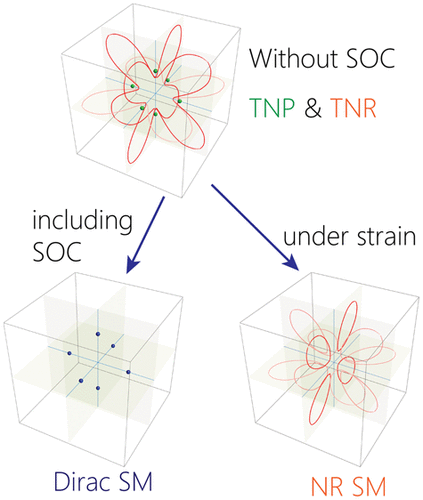当前位置:
X-MOL 学术
›
J. Phys. Chem. Lett.
›
论文详情
Our official English website, www.x-mol.net, welcomes your feedback! (Note: you will need to create a separate account there.)
From Type-II Triply Degenerate Nodal Points and Three-Band Nodal Rings to Type-II Dirac Points in Centrosymmetric Zirconium Oxide
The Journal of Physical Chemistry Letters ( IF 5.7 ) Pub Date : 2017-11-15 00:00:00 , DOI: 10.1021/acs.jpclett.7b02642 Ting-Ting Zhang 1, 2 , Zhi-Ming Yu 3 , Wei Guo 4 , Dongxia Shi 1, 2, 5 , Guangyu Zhang 1, 2, 5, 6 , Yugui Yao 4
The Journal of Physical Chemistry Letters ( IF 5.7 ) Pub Date : 2017-11-15 00:00:00 , DOI: 10.1021/acs.jpclett.7b02642 Ting-Ting Zhang 1, 2 , Zhi-Ming Yu 3 , Wei Guo 4 , Dongxia Shi 1, 2, 5 , Guangyu Zhang 1, 2, 5, 6 , Yugui Yao 4
Affiliation

|
Using first-principles calculations, we report that ZrO is a topological material with the coexistence of three pairs of type-II triply degenerate nodal points (TNPs) and three nodal rings (NRs), when spin–orbit coupling (SOC) is ignored. Noticeably, the TNPs reside around the Fermi energy with a large linear energy range along the tilt direction (>1 eV), and the NRs are formed by three strongly entangled bands. Under symmetry-preserving strain, each NR would evolve into four droplet-shaped NRs before fading away, producing distinct evolution compared with that in usual two-band NR. When SOC is included, TNPs would transform into type-II Dirac points while all of the NRs are gapped. Remarkably, the type-II Dirac points inherit the advantages of TNPs: residing around the Fermi energy and exhibiting a large linear energy range. Both features facilitate the observation of interesting phenomena induced by type-II dispersion. The symmetry protections and low-energy Hamiltonian for the nontrivial band crossings are discussed.
中文翻译:

从II型三重简并节点和三带节点环到中心对称氧化锆中的II型狄拉克点
使用第一性原理计算,我们报告ZrO是一种拓扑材料,当忽略自旋-轨道耦合(SOC)时,三对II型三重简并节点(TNP)和三个节点环(NRs)并存。值得注意的是,TNP位于费米能量附近,沿着倾斜方向(> 1 eV)具有较大的线性能量范围,而NR由三个强纠缠带形成。在保持对称性的应变下,每个NR逐渐消失之前会演变成四个液滴状的NR,与普通的两波段NR相比,会产生不同的演化。当包含SOC时,TNP将转换为II型Dirac点,而所有NR都将留空。值得注意的是,II型狄拉克点继承了TNP的优点:驻留在费米能量附近并具有较大的线性能量范围。这两个功能都有助于观察由II型弥散引起的有趣现象。讨论了非平凡过境的对称保护和低能哈密顿量。
更新日期:2017-11-16
中文翻译:

从II型三重简并节点和三带节点环到中心对称氧化锆中的II型狄拉克点
使用第一性原理计算,我们报告ZrO是一种拓扑材料,当忽略自旋-轨道耦合(SOC)时,三对II型三重简并节点(TNP)和三个节点环(NRs)并存。值得注意的是,TNP位于费米能量附近,沿着倾斜方向(> 1 eV)具有较大的线性能量范围,而NR由三个强纠缠带形成。在保持对称性的应变下,每个NR逐渐消失之前会演变成四个液滴状的NR,与普通的两波段NR相比,会产生不同的演化。当包含SOC时,TNP将转换为II型Dirac点,而所有NR都将留空。值得注意的是,II型狄拉克点继承了TNP的优点:驻留在费米能量附近并具有较大的线性能量范围。这两个功能都有助于观察由II型弥散引起的有趣现象。讨论了非平凡过境的对称保护和低能哈密顿量。



























 京公网安备 11010802027423号
京公网安备 11010802027423号